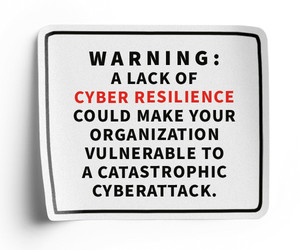For an IT leader, experiencing a data breach can feel like the end of the world. The recovery process can be long and arduous, and your partners’ and customers’ trust won’t be recovered overnight. There may even be legal or regulatory fallout that extends far into the future.
But in today’s threat environment, breaches are inevitable. It isn’t possible to stop 100% of attacks, and while preventive measures are still an important part of any cybersecurity strategy, it’s a mistake to put all of your eggs in the prevention basket. Today’s businesses must also prioritize threat mitigation and breach recovery.
Most important, organizations must show resilience when breaches occur.
LEARN MORE: Incident response is essential to your cyber resilience strategy.
It's a Mistake to Focus Only on Prevention
It’s important for businesses to have preventive measures in place, but attackers are growing more sophisticated by the day. And because modern organizations are digitally connected, it’s easier than ever to exploit security gaps, misconfigurations and other potential vulnerabilities.
That’s why businesses need a plan for containing, remediating and recovering from a breach. That plan needs to extend to every level of the organization because a breach affects everyone. How should the communications team talk about the breach? When should the legal department get involved? Should sales teams press pause? What tone should leadership set?
These are not questions you want to be answering on the fly. A good breach recovery plan should cover all of this and more, and organizations should be conducting regular tabletop exercises to ensure that all employees — from the CEO to the newest entry-level worker — know their role in the recovery process.
Click the banner to discover the benefits of cyber resilience, and learn how to get there.


Make Cyber Resilience Part of the Business
In practice, resilience depends heavily on the ability to be dynamic. That means businesses need continuous visibility across their digital environments to understand where their most sensitive systems and data live, and where any potential exposure lies. The threat landscape is always evolving, so point-in-time snapshots are no longer enough. Businesses that can measure their security capabilities against established benchmarks in real time can use that data to inform the organization’s overall risk posture.
This helps organizations home in on a comprehensive recovery strategy. Knowing which environments are inside or outside the bounds of acceptable risk can lay bare where additional resources are needed.
This is why it’s so critical to run tabletop exercises. A central repository of real-time data from across the organization will enable leaders to practice true-to-life breach scenarios, and help them cross the gulf between understanding what happened and getting the organization back up and running. Tabletop exercises help businesses identify key takeaways that can limit the impact when incidents occur, and they ensure that when a breach happens, no one is left wondering how to respond.
Click the banner below to read the 2024 CDW Cybersecurity Report.


Why Transparency Is Valuable During a Data Breach
Transparency is an underappreciated element of resilience. In today’s world, you can’t keep a breach quiet, nor should you try. The truth always comes out. In fact, when it comes to letting your partners and customers know what’s going on, the smart move is to be overly communicative (to the extent your general counsel is comfortable with that). Breaches happen, and most customers understand that today. They value transparency. If you can show them how you mitigated the impact of a breach and the steps you’ve taken to ensure it doesn’t happen again, that will help the organization more than trying to hide it.
This is why resilience is important. An organization with a strong breach recovery plan should be able to clearly and effectively communicate to customers why the breach occurred, what steps were taken to minimize its impact and how the company was able to restore normal operations. Transparency allows partners and customers to see that your company exhibited the resilience required to bounce back quickly and avoid major fallout. That’s a huge positive — and it’s the sort of thing customers and partners remember when it comes time to renew their contracts.
UP NEXT: Three companies have improved their cyber resilience with IAM strategies.
A breach isn’t necessarily a deal-breaker; after all, a company only willing to do business with those who consider themselves immune from a breach will have a very hard time finding partners. In today’s environment, it is far more important to demonstrate that you are well positioned to respond quickly and transparently if a breach happens, and that your business has the resilience to avoid costly outages and downtime. Trust is earned, and the best way to earn it is to demonstrate that while you hope for the best, you’re prepared for the worst.
akinbostanci/Getty Images













